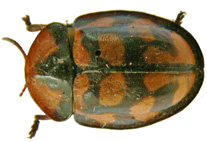Abstract
The genus Botanochara Dejean, 1836 comprises 43 species distributed in the Neotropical Region, among which 26 (57%) are known from Argentina. Botanochara praefica (Spaeth, 1940) is synonymized with B. macularia (Boheman, 1850). Botanochara missionea (Spaeth, 1915) and B. tessellata (Burmeister, 1870) are illustrated for the first time. Botanochara duodecimnotata (Boheman, 1850) and Botanochara segnis (Boheman, 1862) are new country records. Six species are shared with Bolivia, 21 with Brazil, 15 with Paraguay, one with Peru, and 7 with Uruguay. The known geographic distributions, synonymies, hybrids, chromosome numbers, and host plants in Argentina and adjacent countries are summarized. New localities and host plants, and some corrections of misidentified species from Argentina are given. Distribution maps of all species in Argentina with known localities superimposed with biogeographic provinces are provided. The southern limits of Botanochara in western, central and eastern Argentina are established and correlates with the known distributions of Ipomoea L. species (Convolvulaceae). A total of 12,815 specimens of Cassidinae were found inside birds’ nests from Argentina, from which 11,538 (90.03%) belong to 8 species of Botanochara; 9,331 (80.87%) were found during Autumn (21th March to 20th June) and Winter (21th June to 20th September) (diapause), and 2,207 (19.13%) during Spring (21 th September to 20 th December) and Summer (21 th December to 20 th March) (aseasonal quiescence). Additional records of two other Cassidinae found in birds’ nests and other protected places, Carlobruchia tricostata (Spaeth, 1907) and Stolas lacordairei (Boheman, 1850), are also provided.

